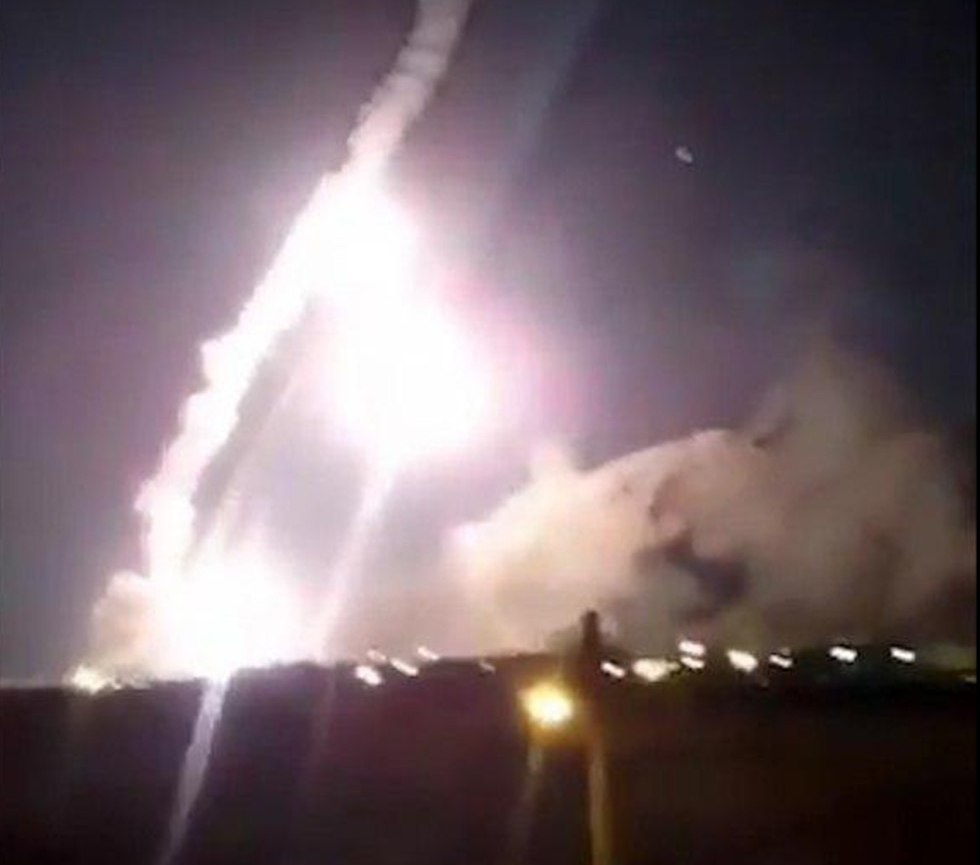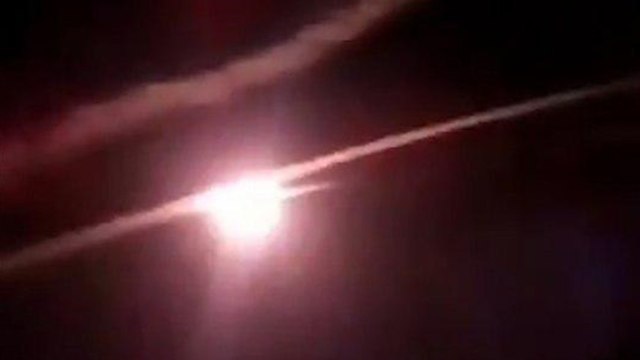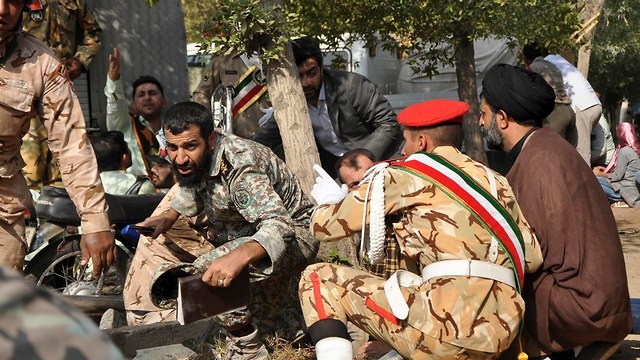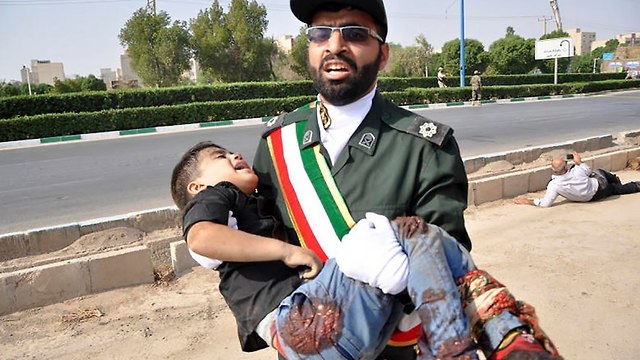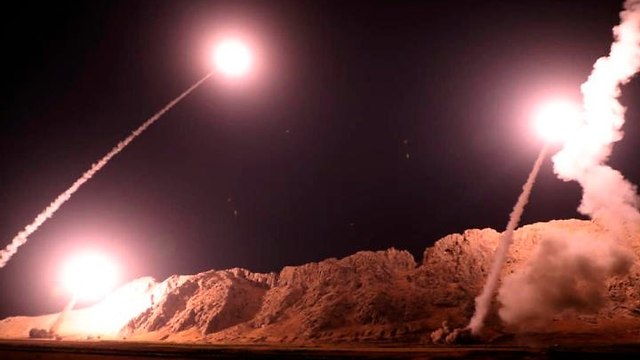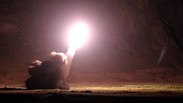

Iran’s strike in Syria is a warning to the West and Gulf states
Analysis: Even though Iran is aware that local terror group is behind the attack on a military parade that killed 29 people, it decided to retaliate by bombing IS positions in Syria in order to convey a message to the US forces in the region and to indicate to the Gulf states that they might also find themselves under the Revolutionary Guard’s mercy.
Iran's Revolutionary Guards apparently have a pattern: the terrorist attack on the regime's facilities and symbols within Iran is being met with a medium-range missile attack. This was the case in June 2017, when the Islamic State (IS) attacked central Iran and killed civilians and government officials inside their offices.
This was also the case nine days ago when an unidentified organization attacked a Revolutionary Guards military parade in the southwest Iranian city of Ahvaz. Twenty nine people were killed—half of whom belonged to the Revolutionary Guards.
Iran, which blamed Israel, Saudi Arabia and the United States, promised to avenge the attack in Ahvaz.
Two organizations claimed responsibility, including a local organization called Al-Ahwaziya, the larger of the two, which seeks to separate the western part of Iranian Khuzestan from the Islamic Republic itself.
Khuzestan Province—the capital of which is Ahvaz—is mainly populated by Sunni Arabs, while Iran is a Shiite state.
As a number of terrorist organizations operate against the Iranian regime in Khuzestan, there is constant unrest in this neglected region of the country.
The Iranians claim that Saudi Arabia was behind the attack, and that it secretly supports Al-Ahwaziya.
Now the Islamic Republic claims that both the United States and Israel support the organization in order to "undermine the regime."
The reason being is that a terrorist attack presents the regime as helpless and incapable of protecting its citizens. An attack on the capital of Khuzestan's capital in which 29 military men were killed is a mortal blow to the status of the regime in Tehran.
The second organization claiming responsibility for the attack was IS. Although the Islamic State has lost its major centers in Iraq and Syria, it still has cells and operating grounds in both countries, as well as in Yemen and the Sinai Peninsula.
Moreover, the pattern of the attack in Ahvaz is very similar to the attacks carried out by IS in numerous locations throughout the Middle East.
As stated, Iranian officials promised to retaliate and attack Saudi Arabia, the United States and Israel, who, according to them, support both Al-Ahwaziya and IS.
It was convenient for the spokesman of the Revolutionary Guards to claim that the attack was carried out by Al-Ahwaziya and not by the Islamic state.
However, the Revolutionary Guards's counterattack targeted IS cells in Syria, located east of the Euphrates River, not far from the border with Iraq.
This is a puzzling fact, since the Revolutionary Guards' spokesman claimed that Al-Ahwaziya was behind the attack in Iran, but Iran's counterstrike targeted an IS base in Syria.
Perhaps Iran chose to target IS since it became clear that they were responsible for the attack.
A more likely possibility is that targeting IS served other purposes: launching long-range missiles from the Islamic Republic to Syrian territory showcases the Revolutionary Guards' prowess, which had to rebuild its damaged reputation.
The head of the Foreign Affairs and Defense Committee in Majlis (the Iranian parliament) accused the Revolutionary Guards of being negligent and cowardly.
At the time of the attack, Revolutionary Guards' snipers were stationed on rooftops surrounding the military parade. They did not shoot the assailants even though they could easily do so.
Such a strong statement by a senior Iranian official certainly did not go unnoticed, it certainly did not render Qasem Soleimani, Major General in the Islamic Revolutionary Guard Corps (IRGC), indifferent.
Therefore, Soleimani had to demonstrate a missile capability that would restore his honor.
A year ago: missiles missed the mark, and the world laughed
A year ago, in June 2017, when IS attacked a government office in the center of Tehran, the Iranians launched Zulfiqar missiles capable of reaching 700 kilometers.
Several missiles were launched from western Iran and missed their targets. As a result, the Revolutionary Guards became the laughing stock of the Western world.
It is still unclear which missiles the Iranians used when they attacked IS during the night.
The Islamic Republic claimed they managed to hit and kill "many", but this information was not confirmed by a reliable source.
It was also reported that some missiles landed in the villages of Iran and Iraq before reaching their destination, but this reports too is unconfirmed.
The main issue is that the Iranians did not target the local Al-Ahwaziya organization, which doesn’t have cells in Syria, but against IS, at a base near the Iraqi border.
It is more than likely that by launching the long-range missiles the Revolutionary Guards also meant to send a threatening message to the West.
Western countries—the United States, the European Union, and of course Israel—demand that Iran stops developing or using ballistic long-range missiles that can carry nuclear warheads.
This is one of the main points of contention between Iran, the United States and the West.
US President Trump demanded that Tehran stop developing and producing the same missiles— even though this was not stipulated in the nuclear deal with Iran.
Therefore, Iran's latest move is a defiant move against the United States, whose special forces are fighting IS in the same region bombed by the Iranians.
By targeting Syria, the regime also sent a message to Saudi Arabia, the United Arab Emirates and other Arab countries in the Persian Gulf—Iran is capable of launching missiles and causing harm even from its sovereign territory.
It is possible that the attack on the military parade nine days ago was indeed carried out by Al-Ahwaziya, but the Iranians had to send a threatening message regarding the missiles it was developing.
Therefore, the Revolutionary Guards attacked IS, who were situated within range, instead of attacking the party responsible for the parade attack.
But the question remains whether Iran's missiles fail to hit the target, just as they did a year ago.














